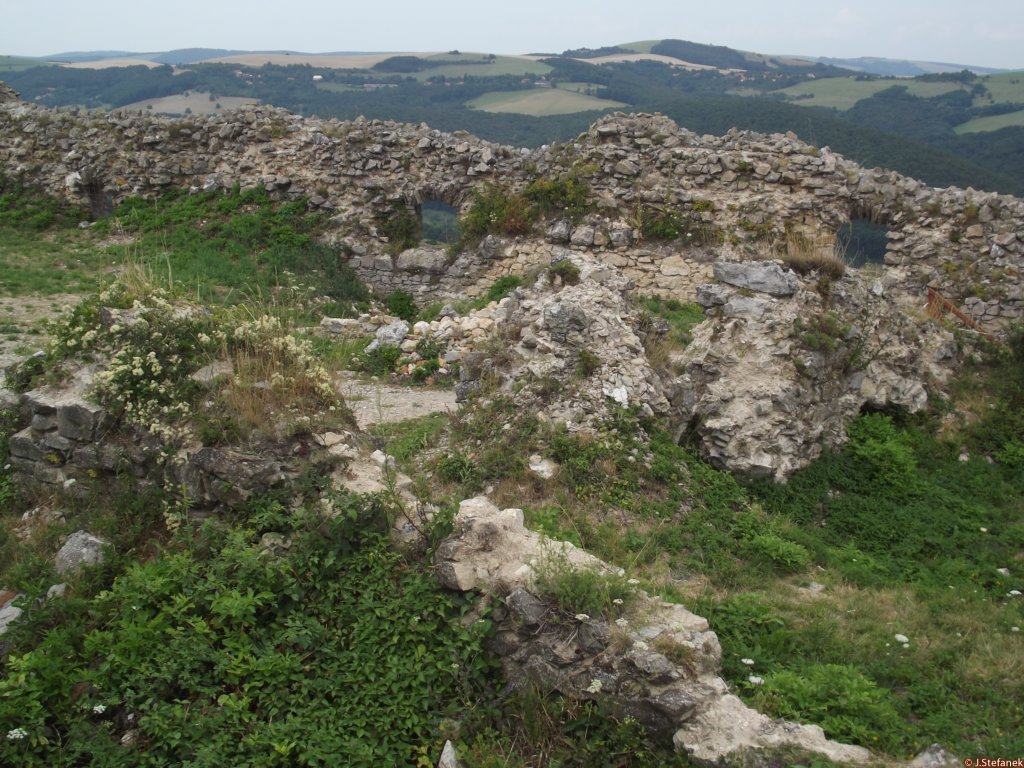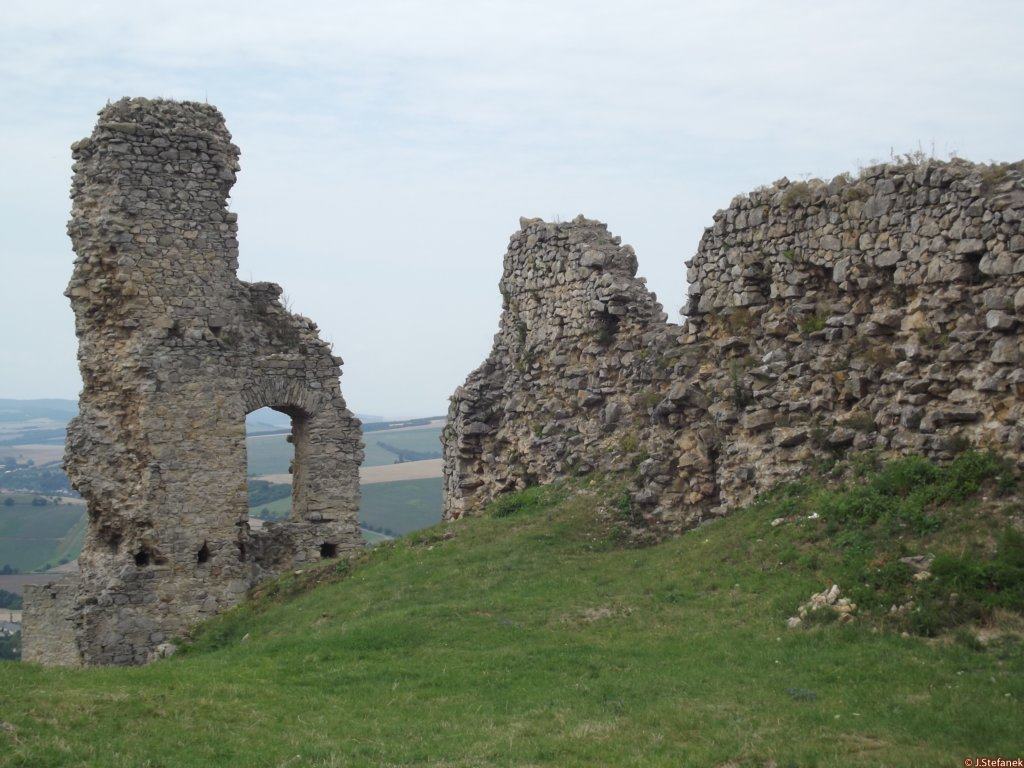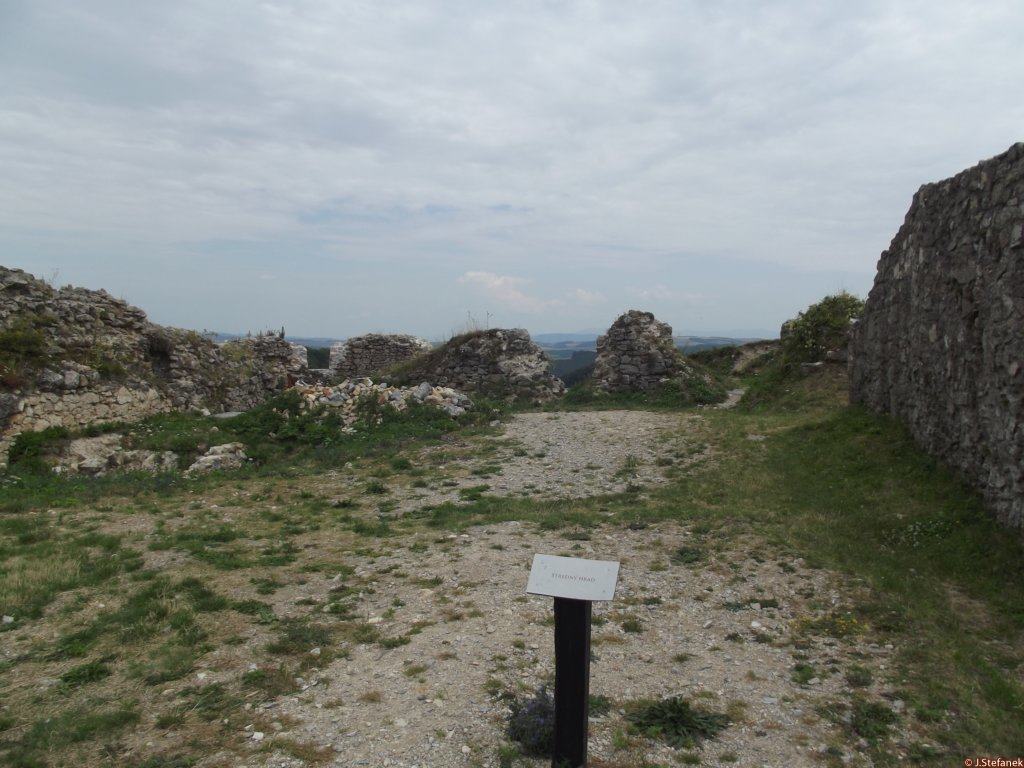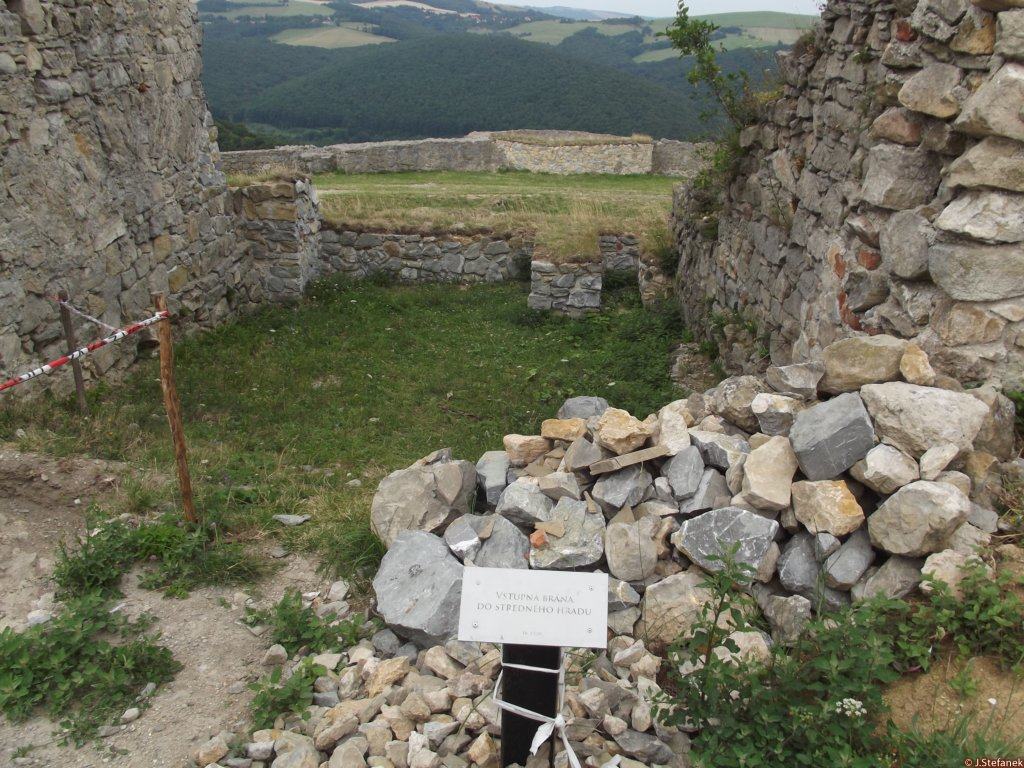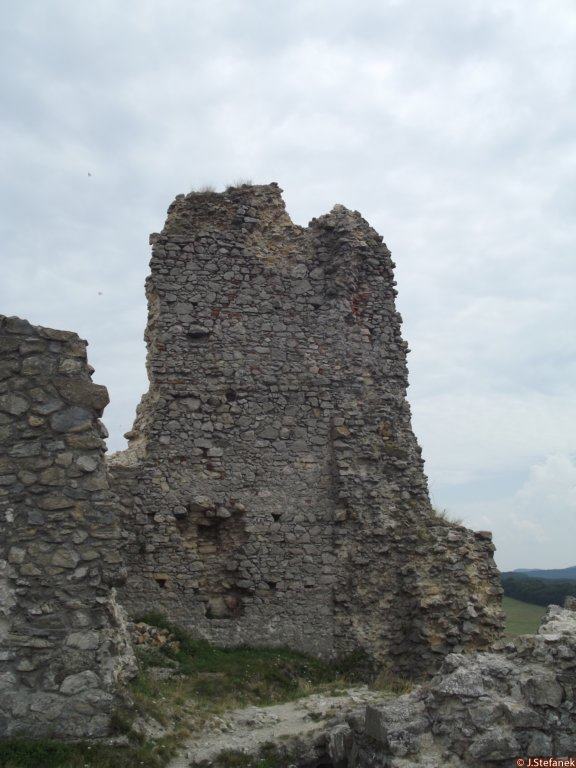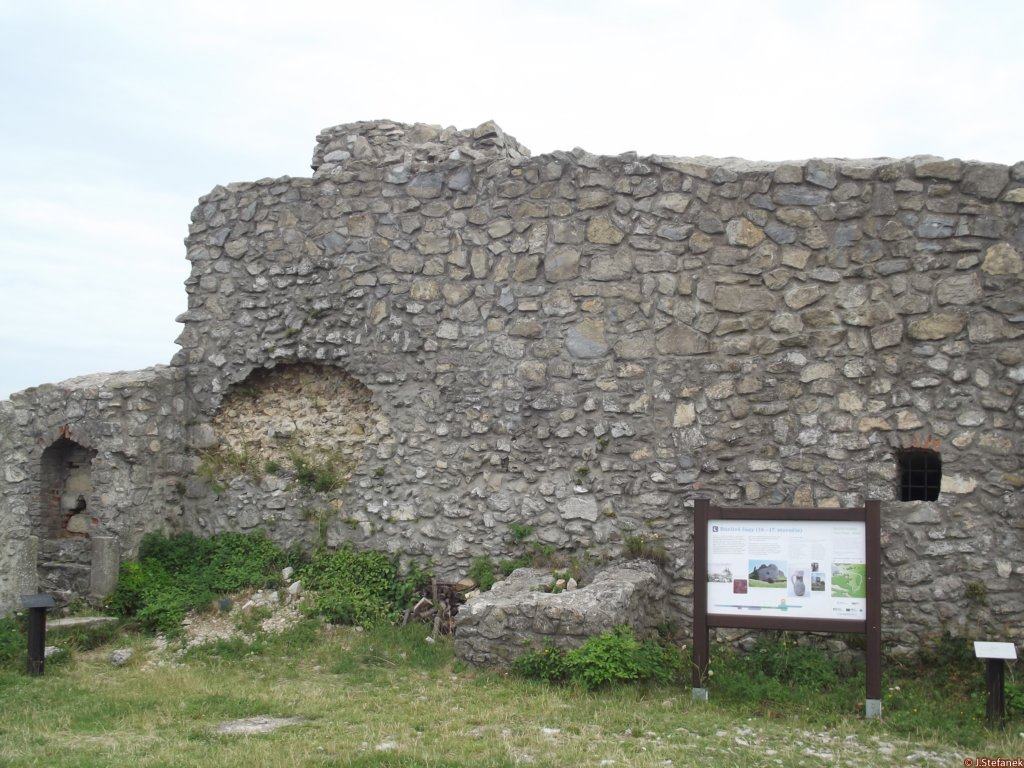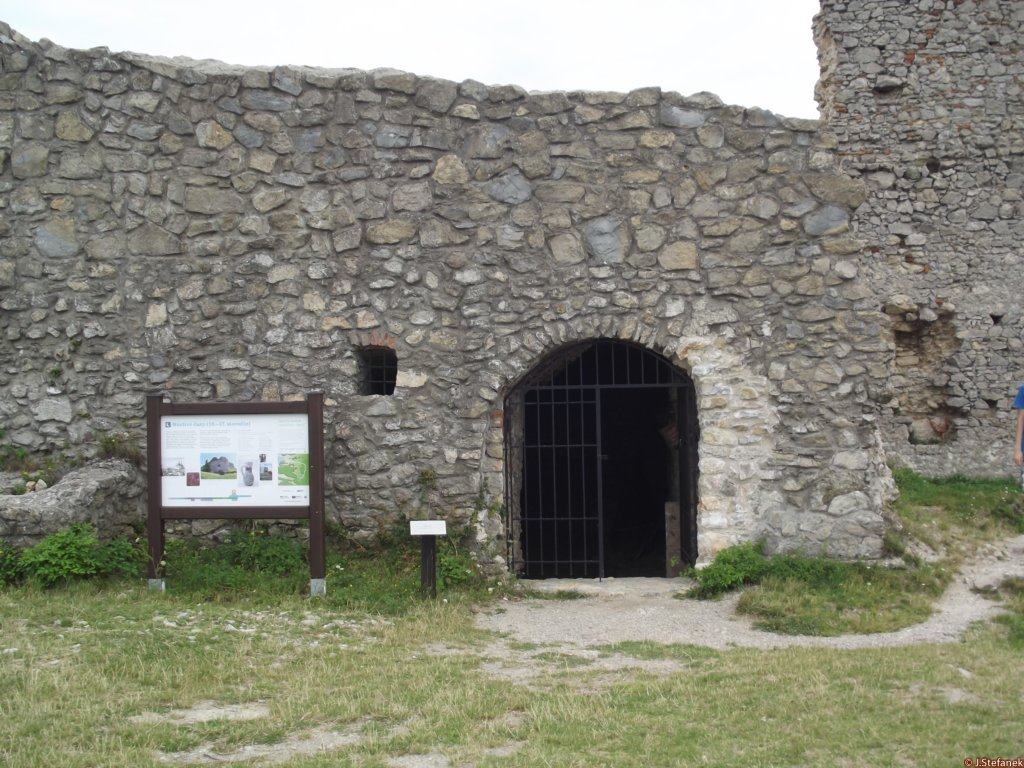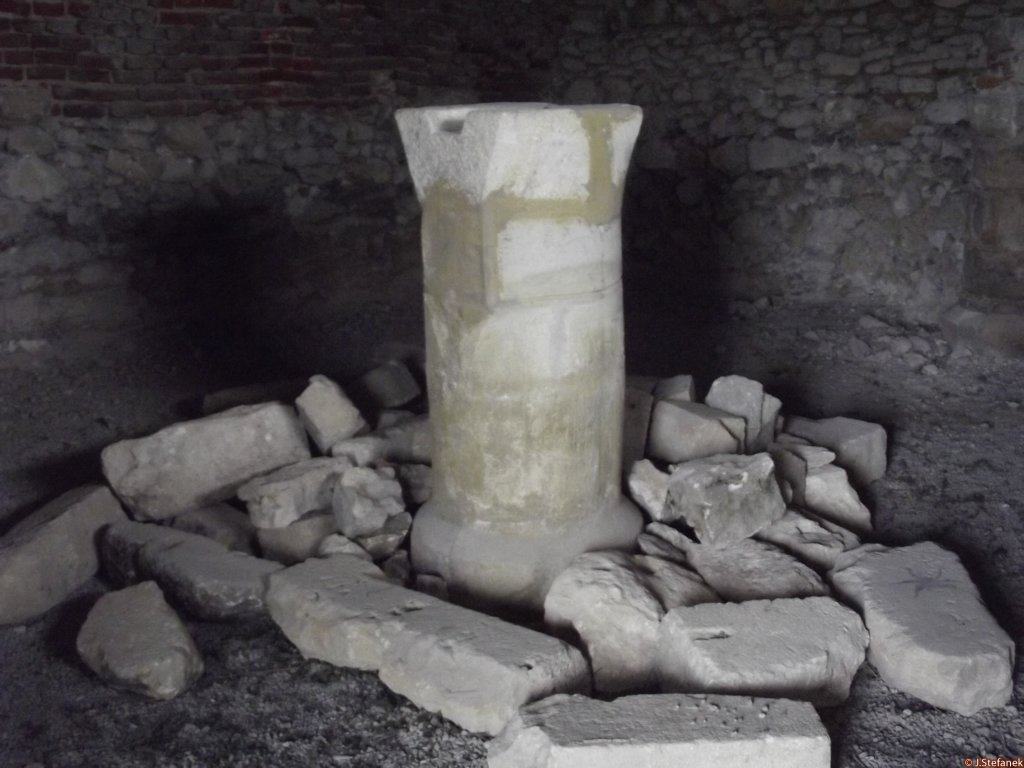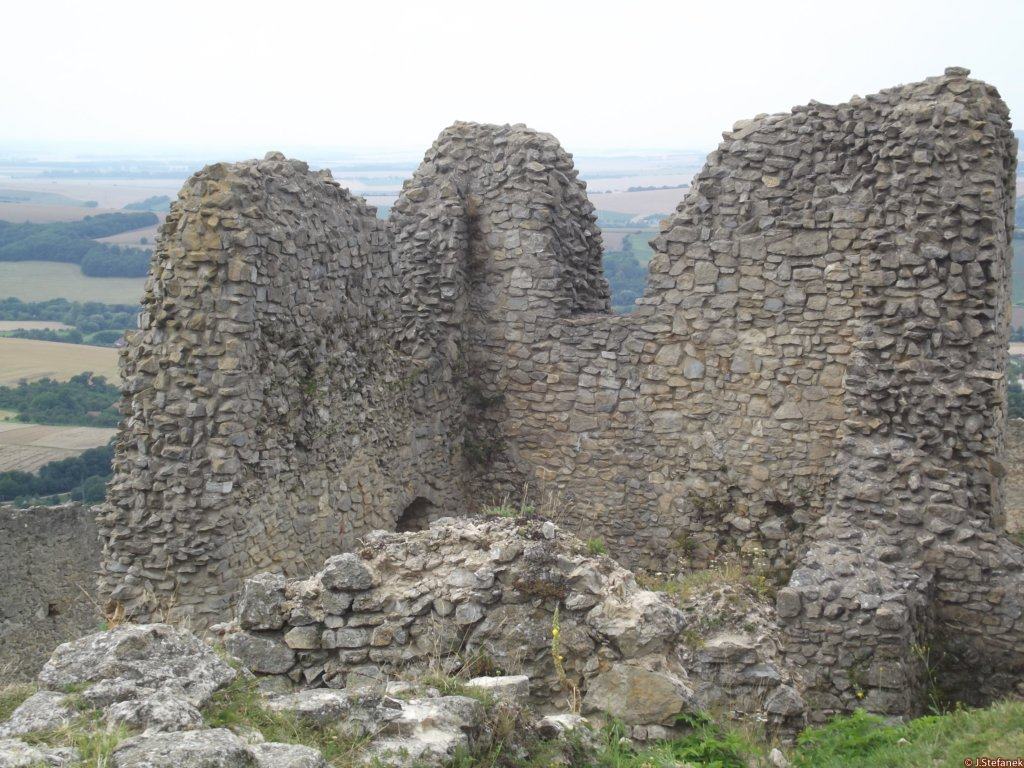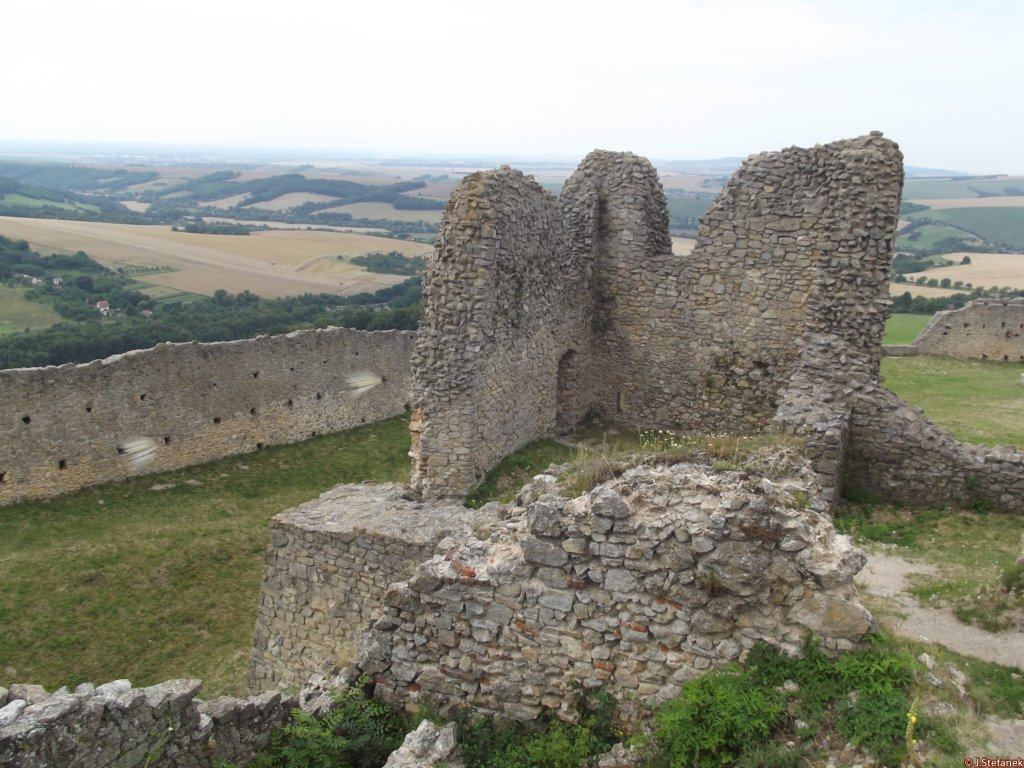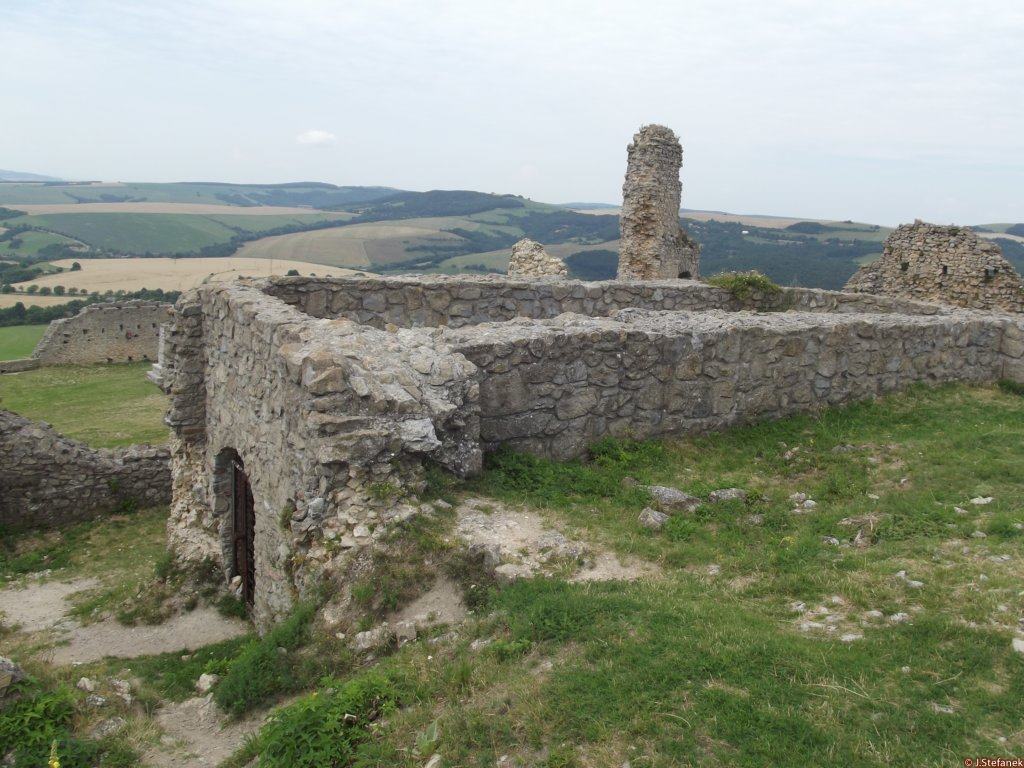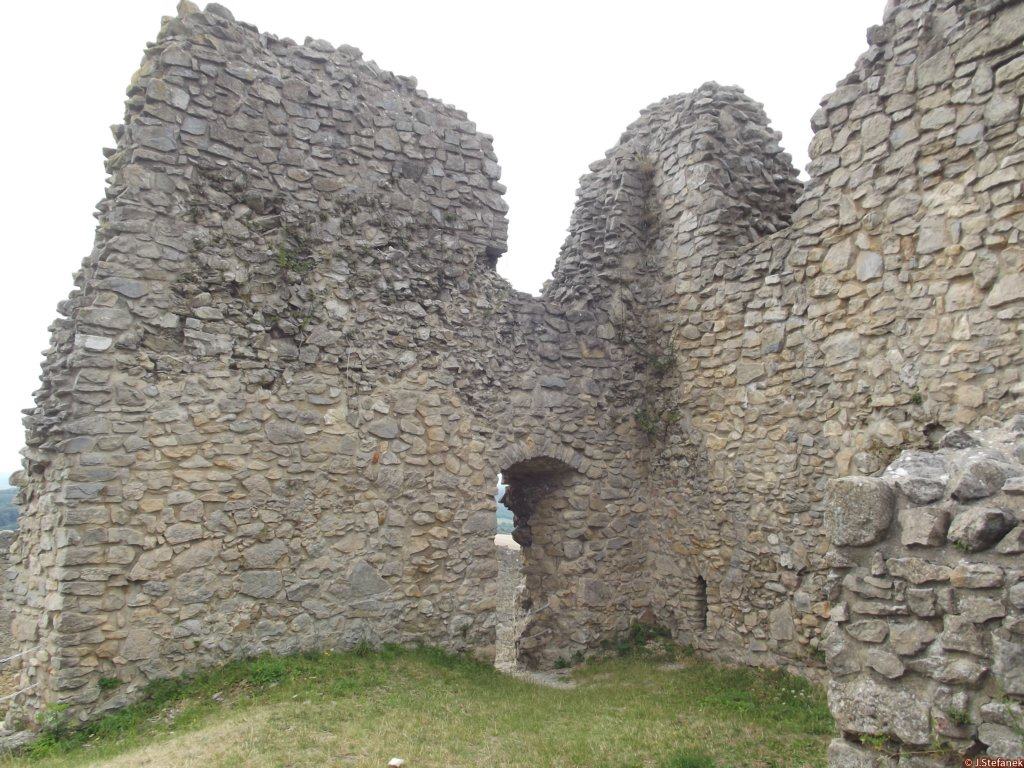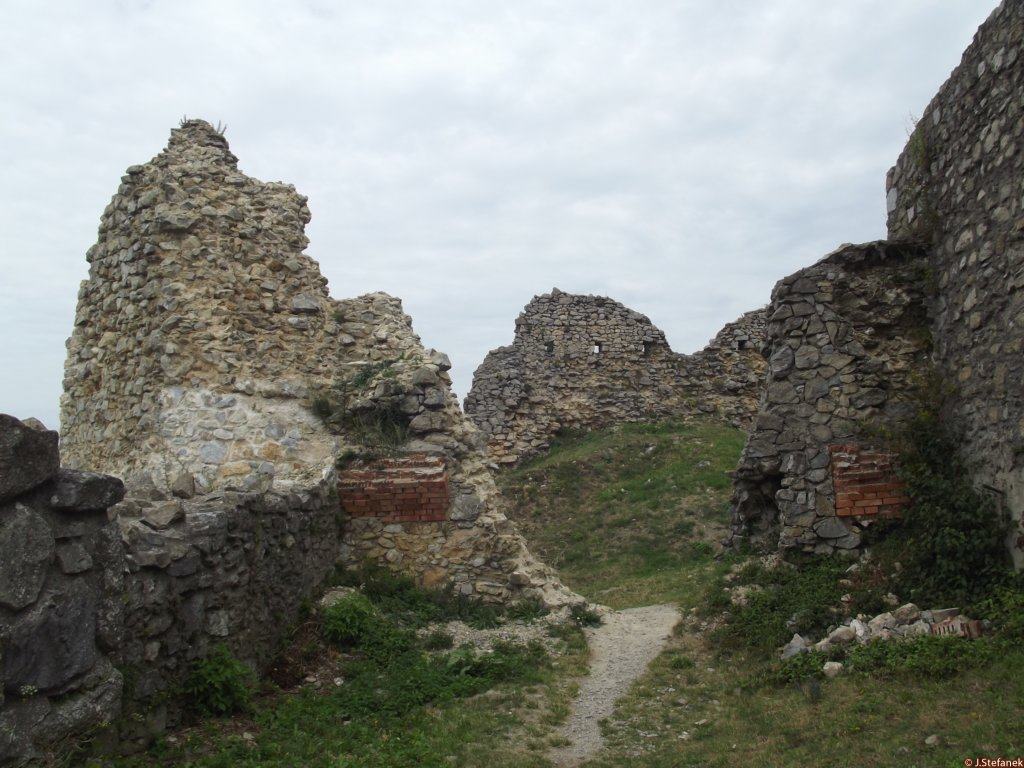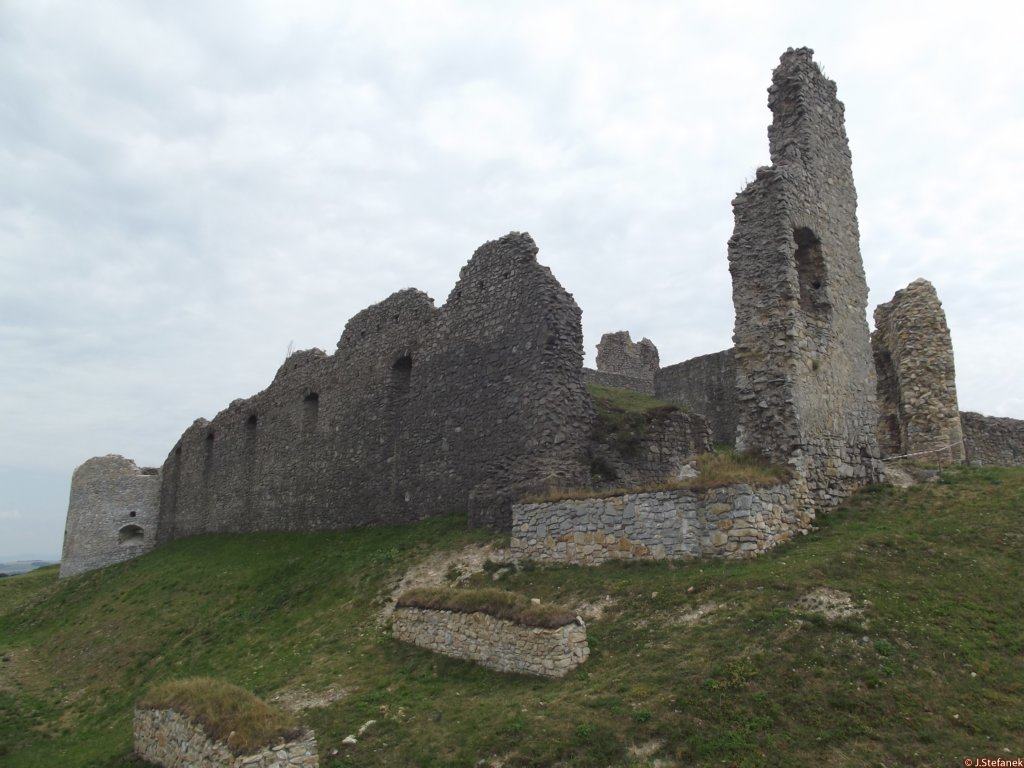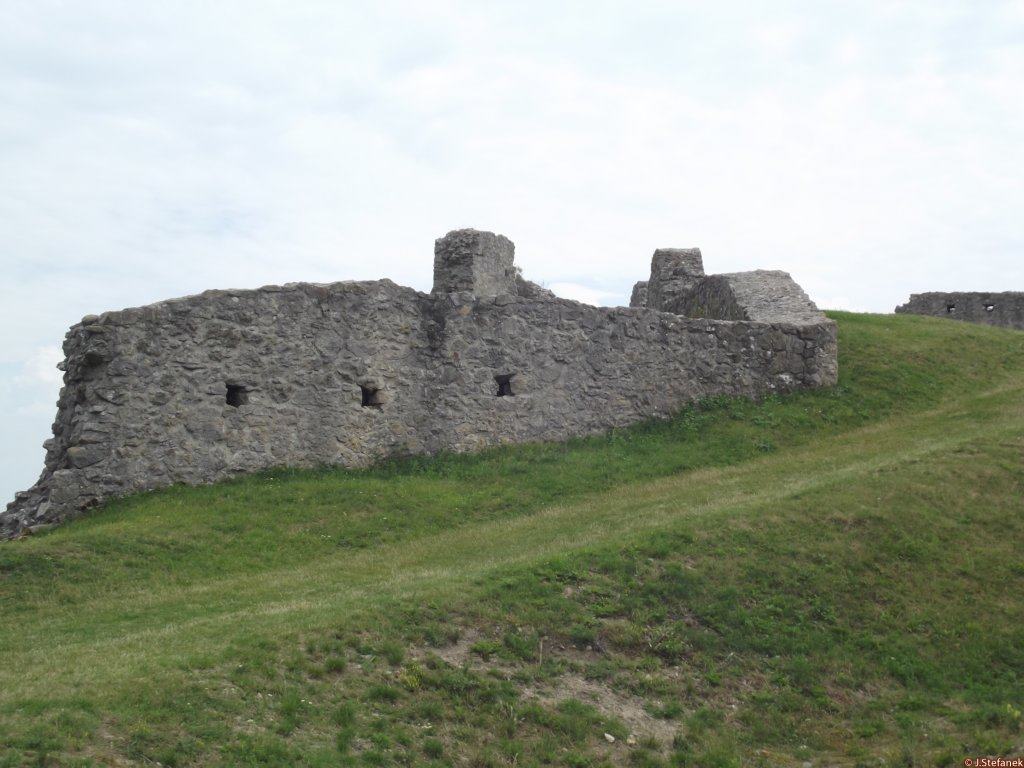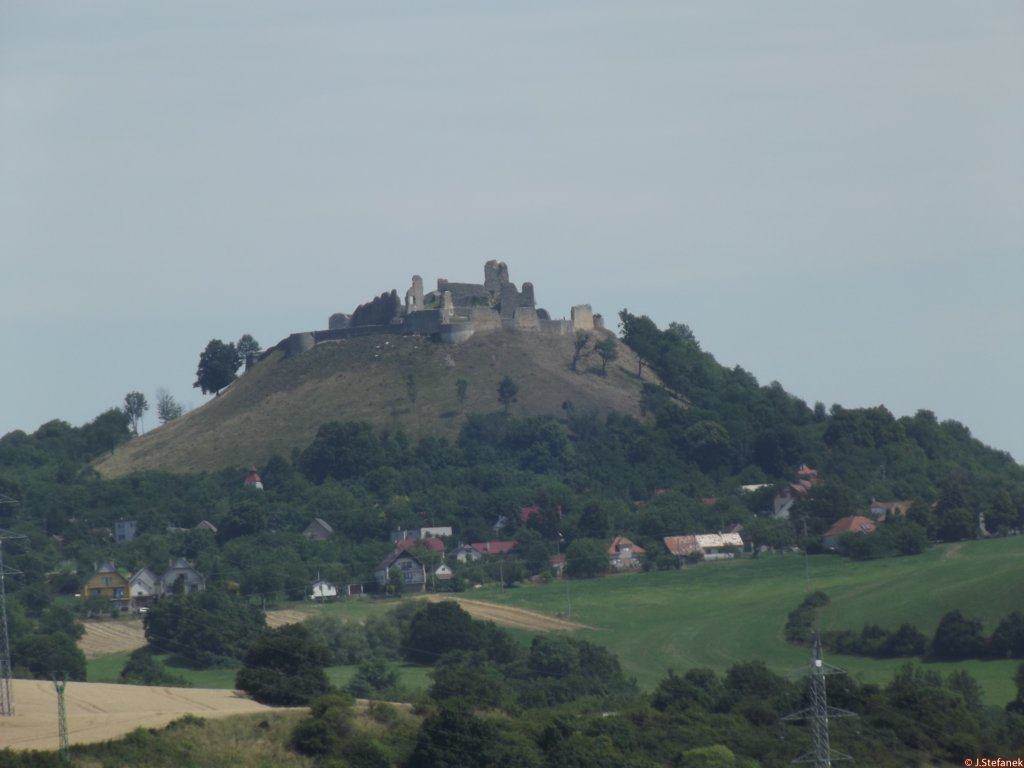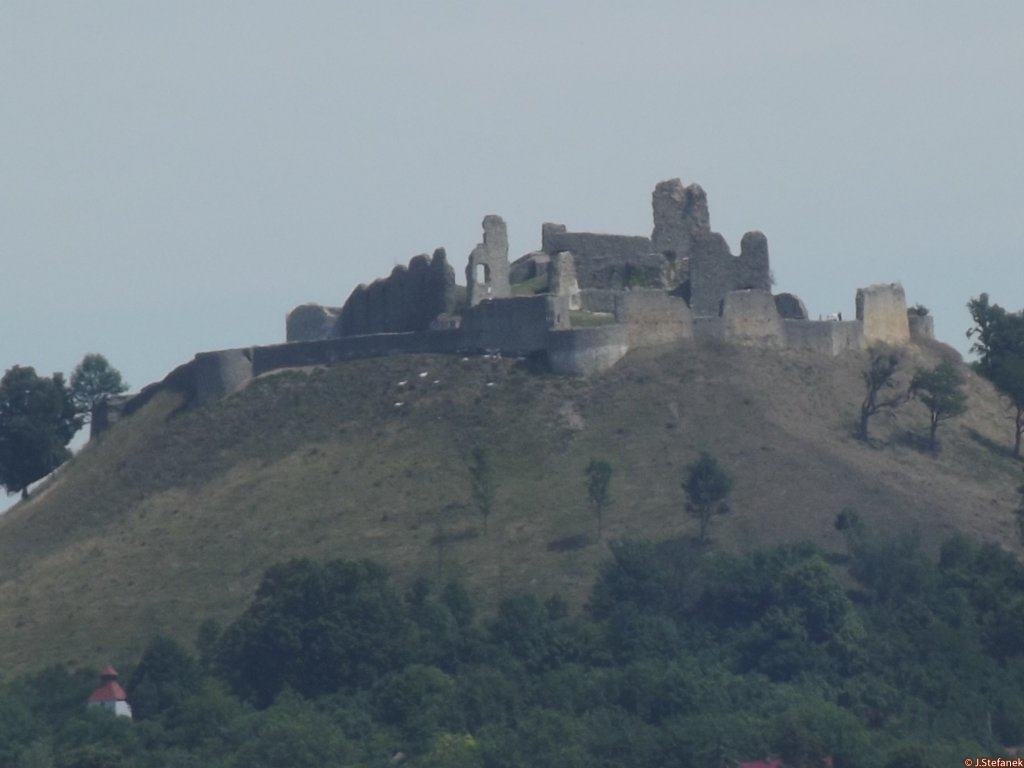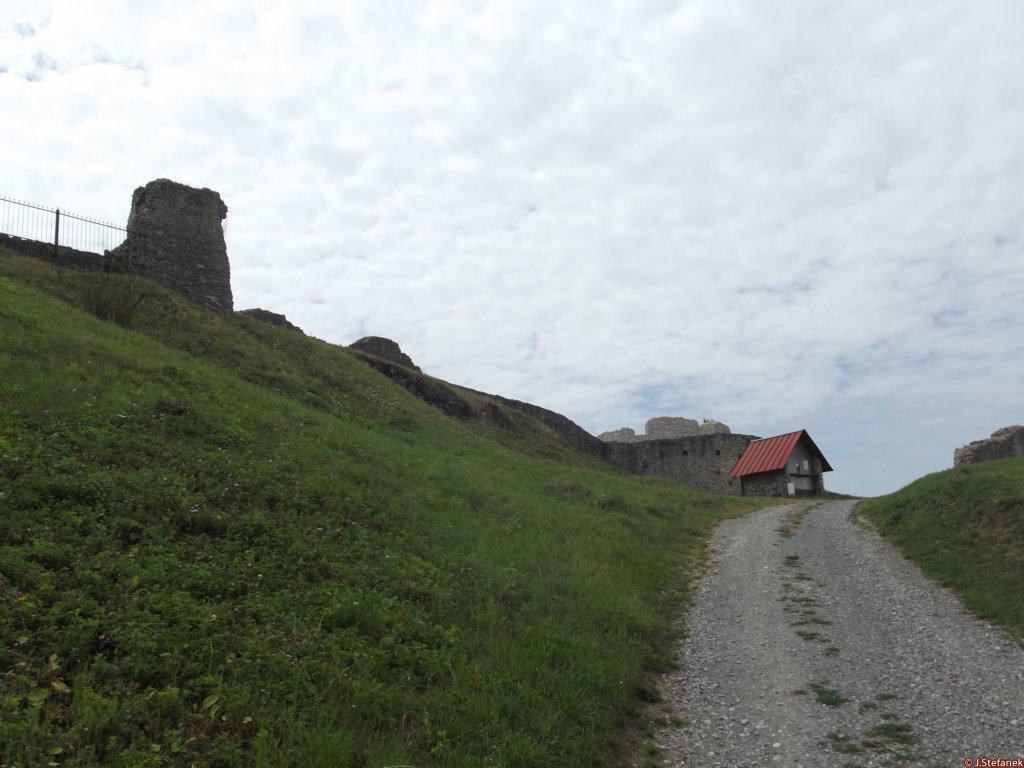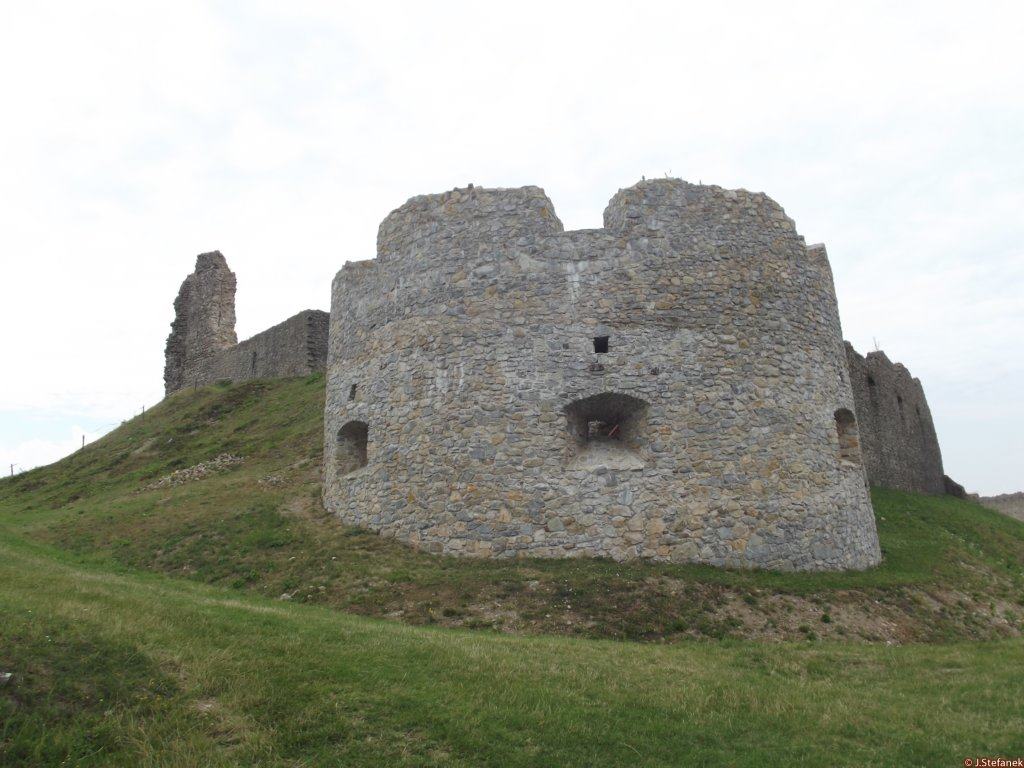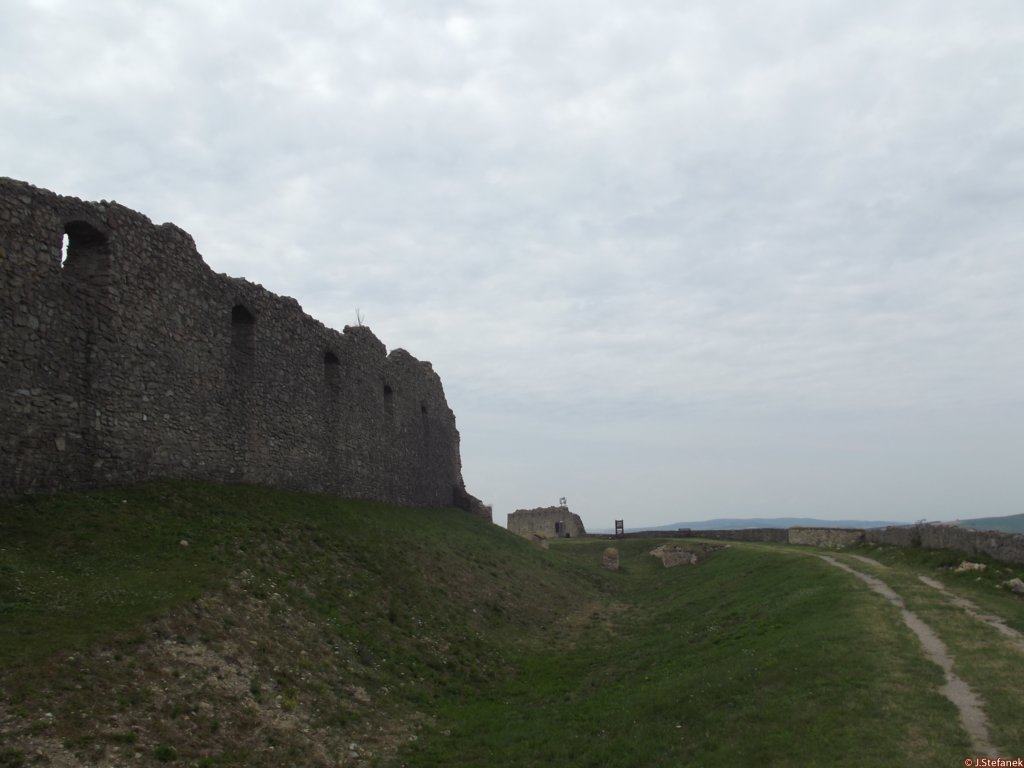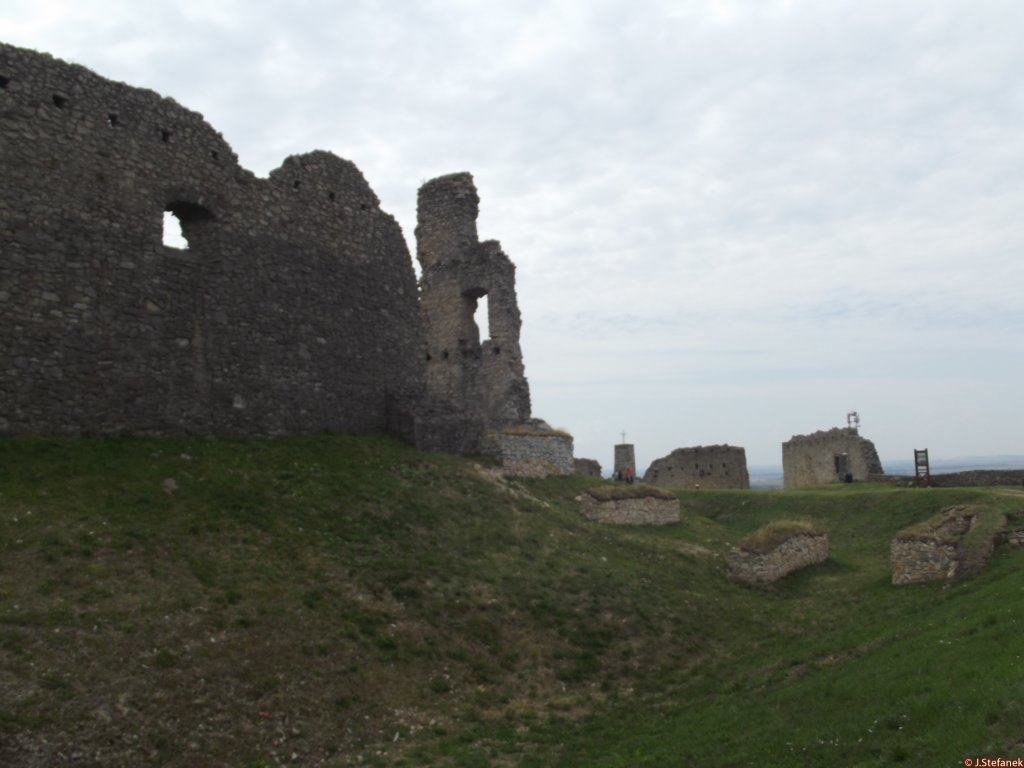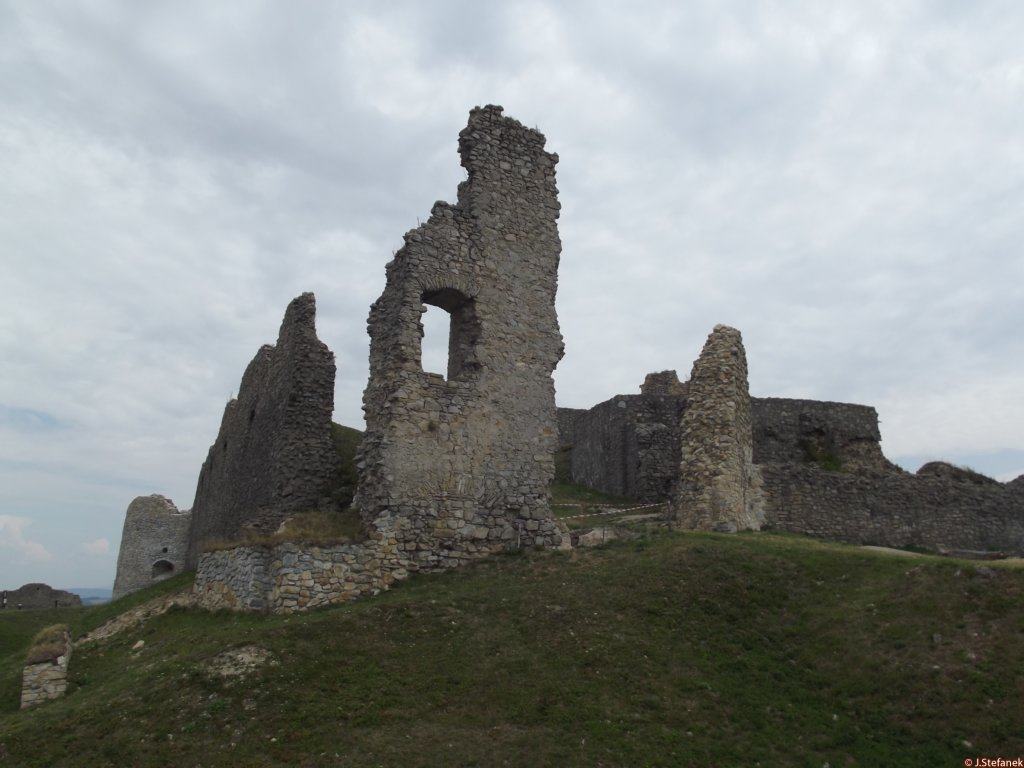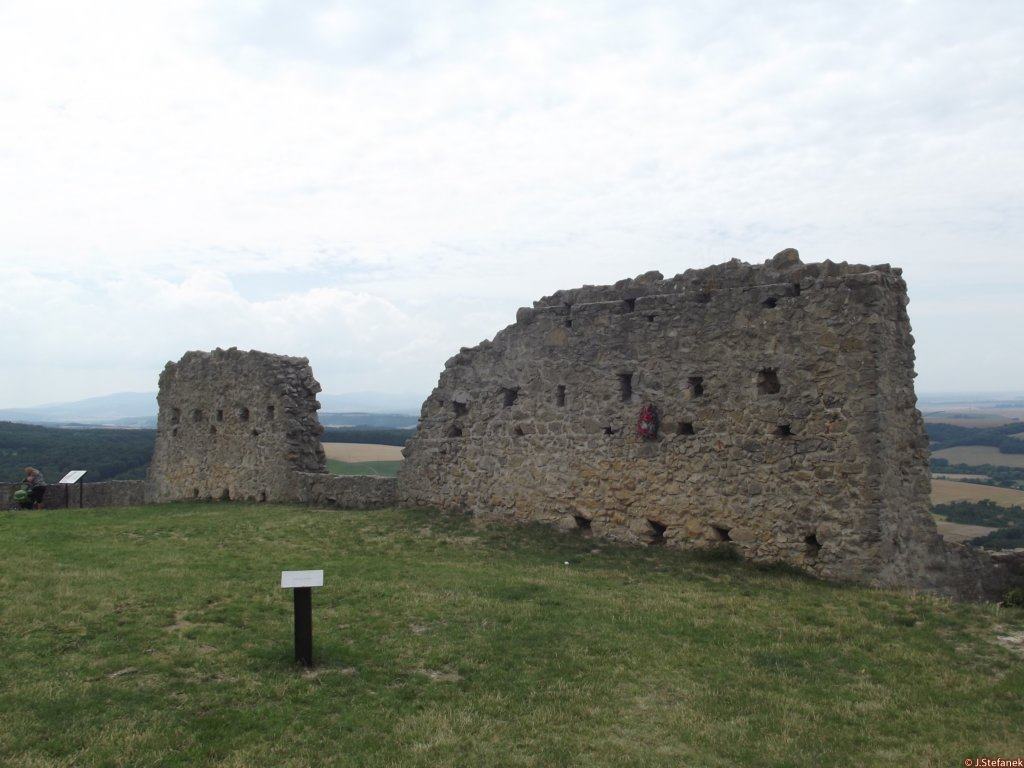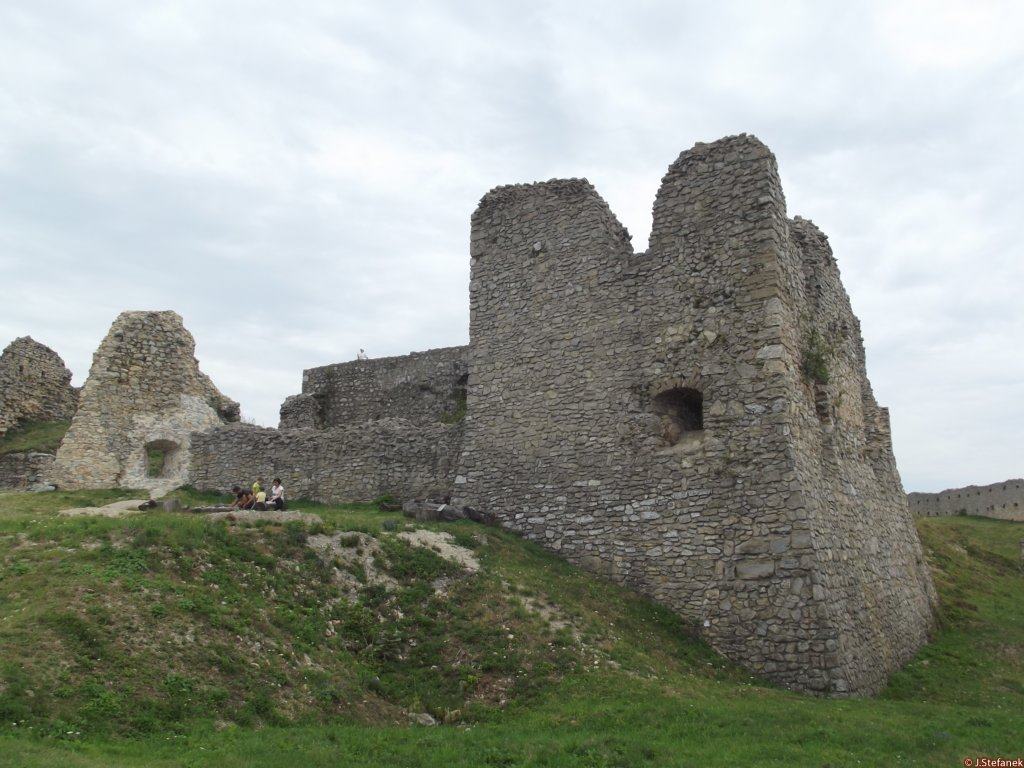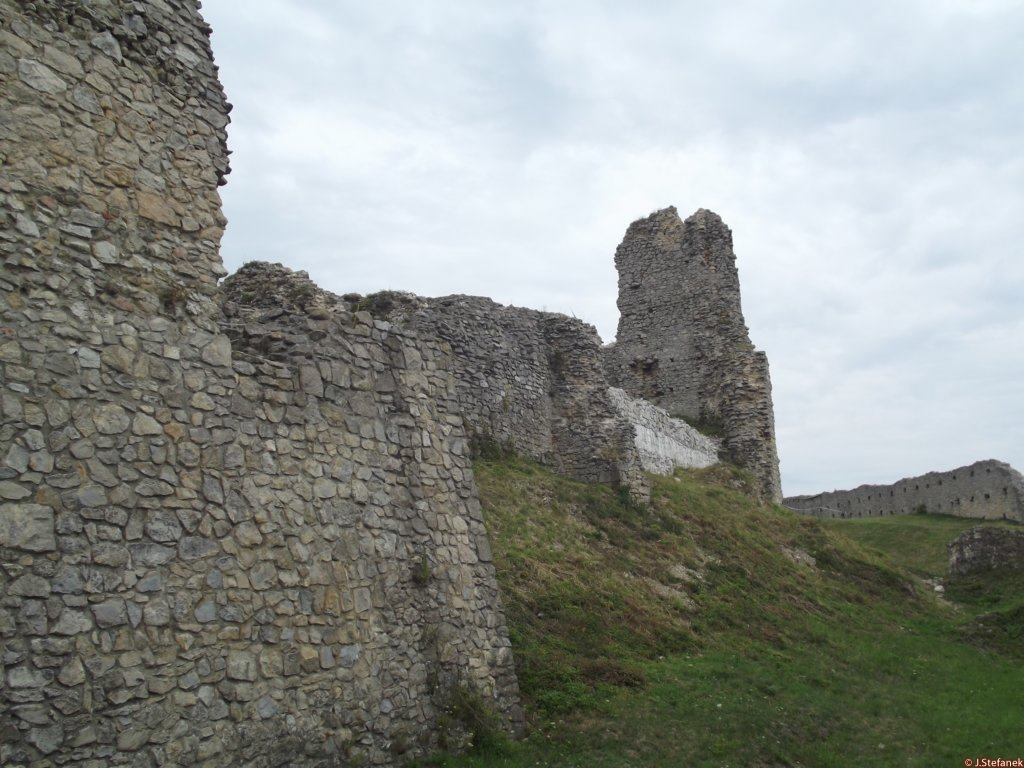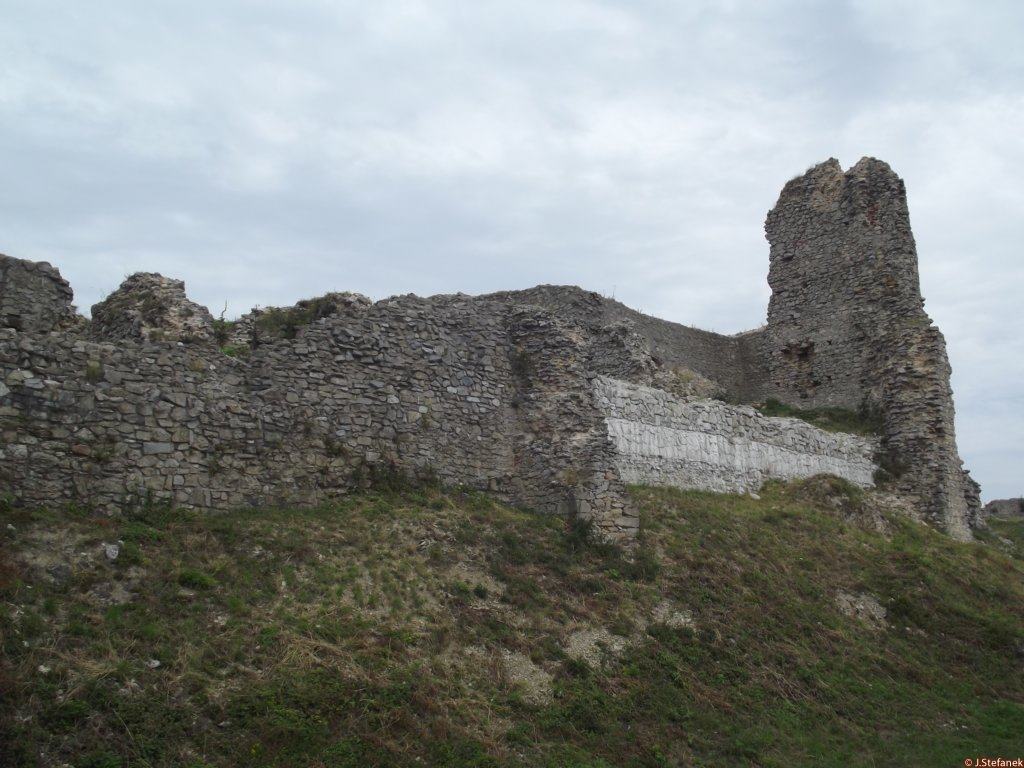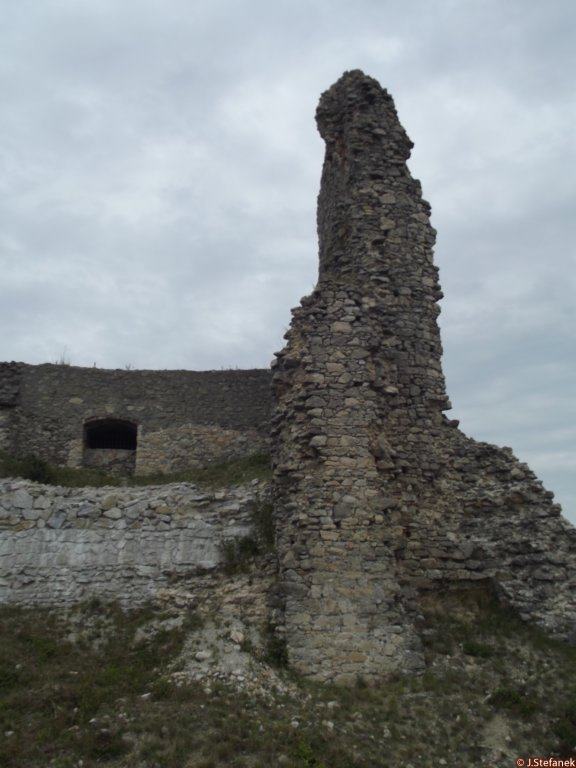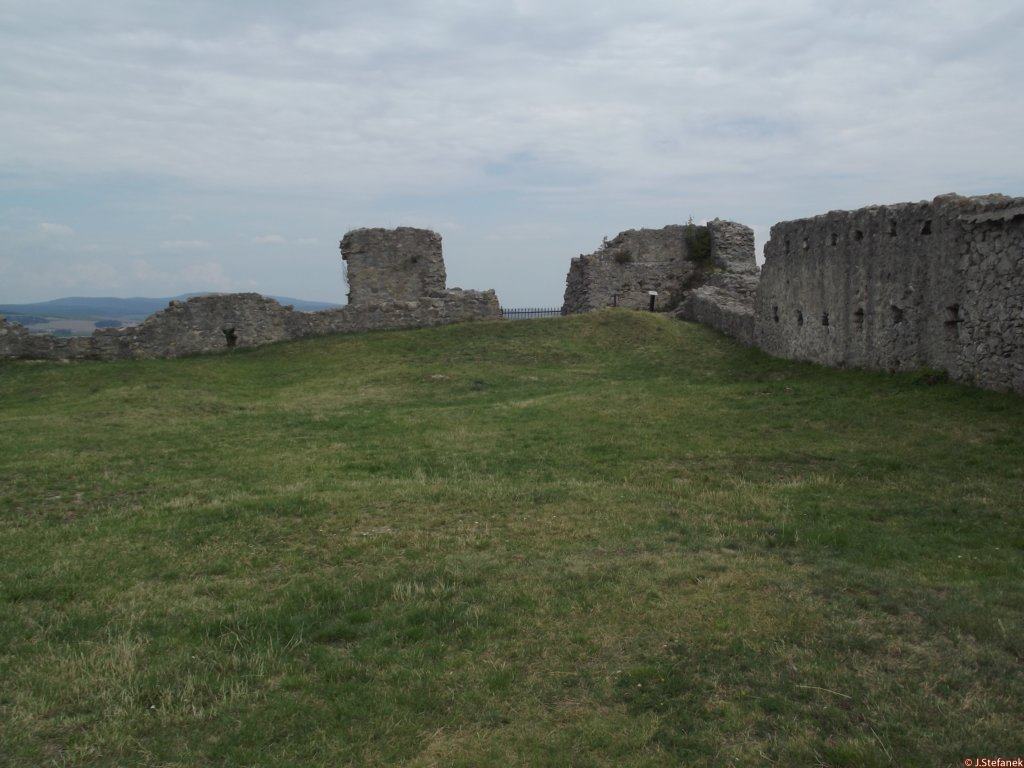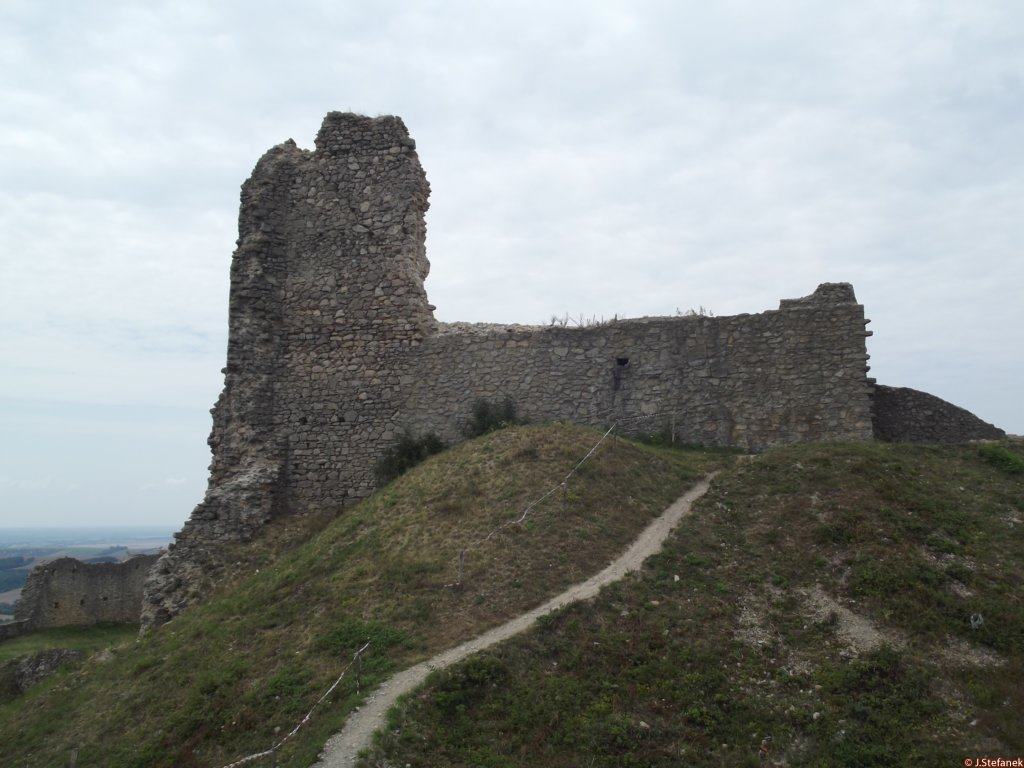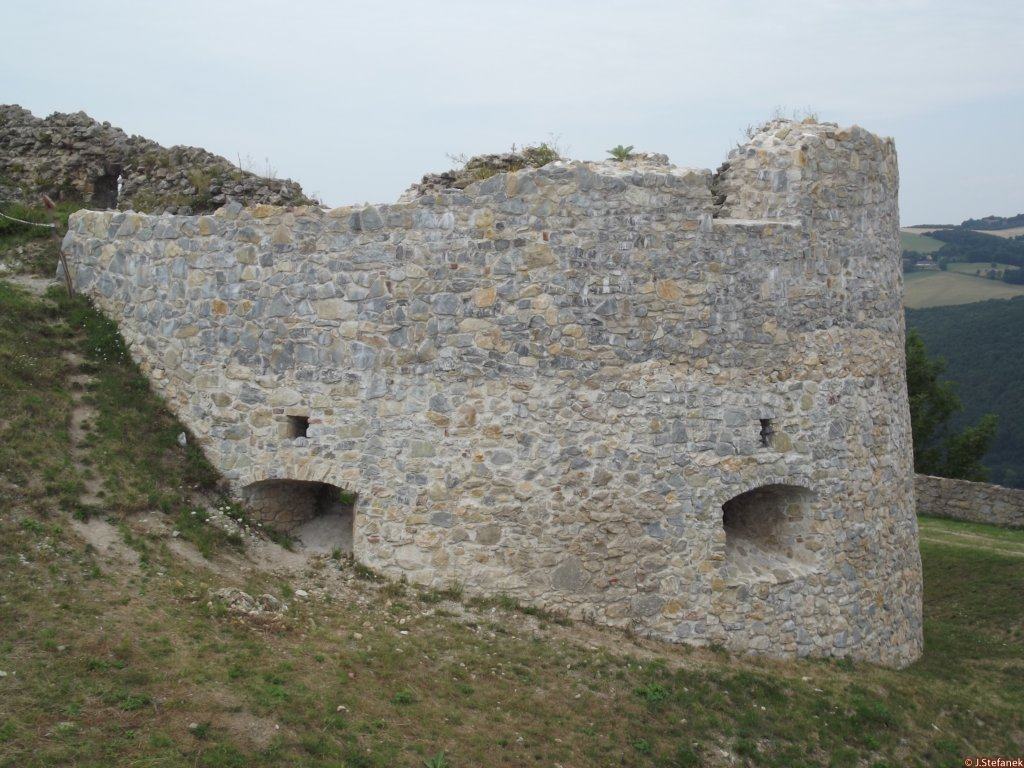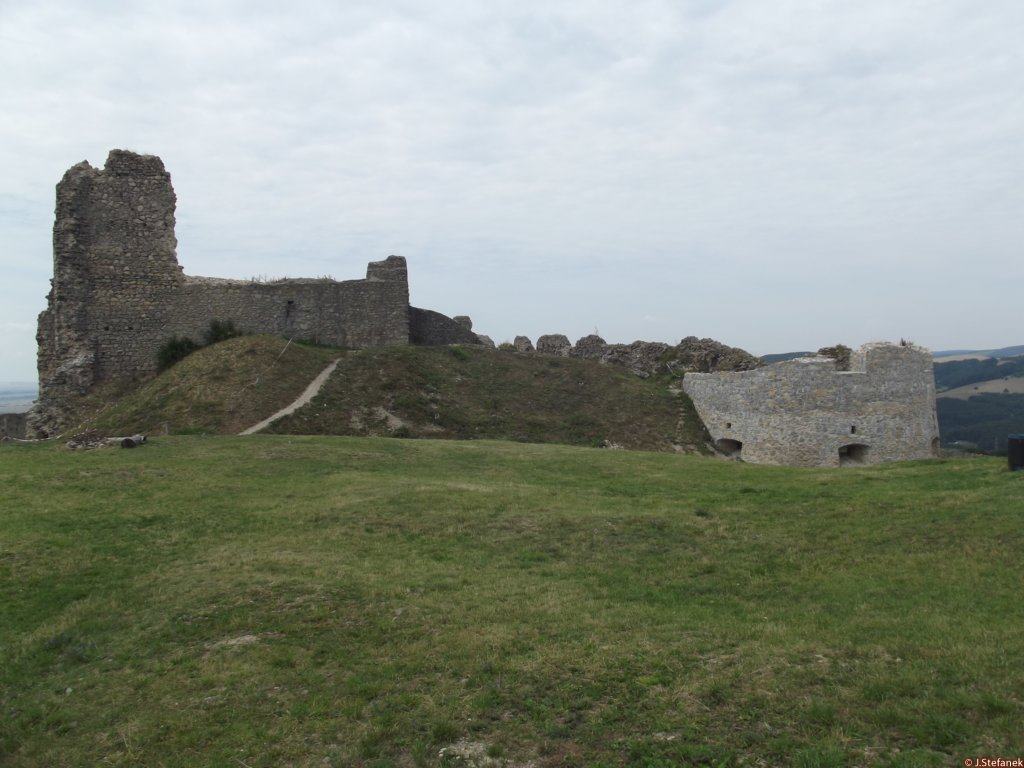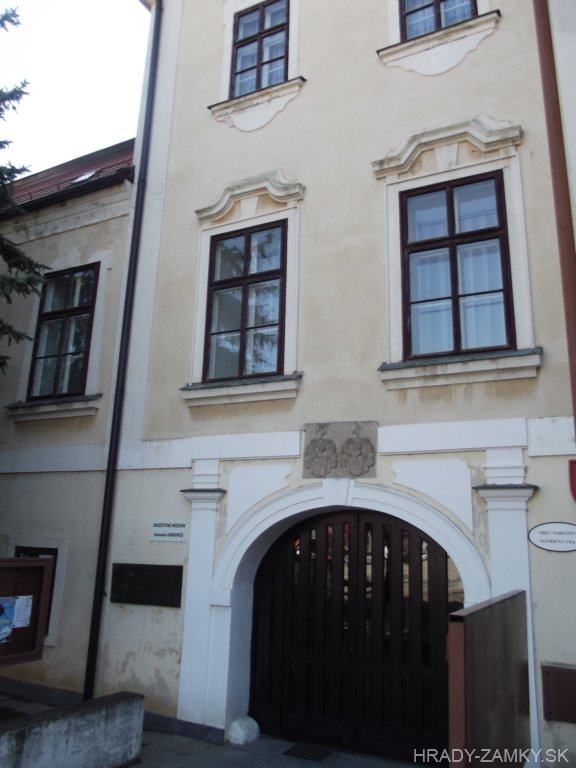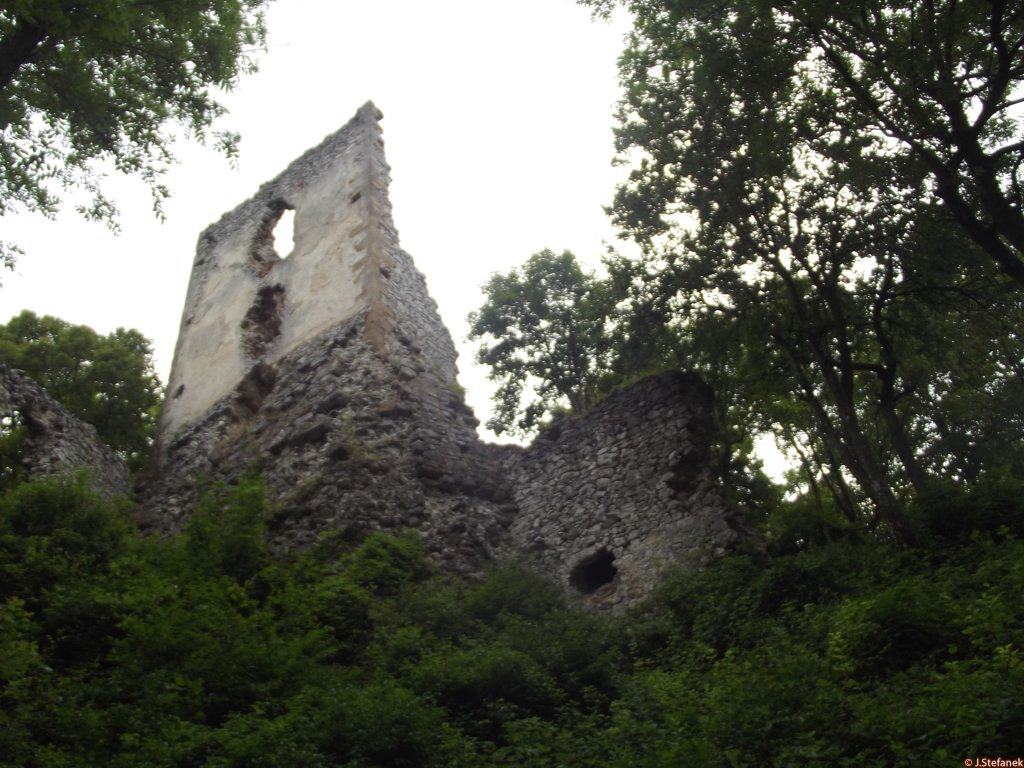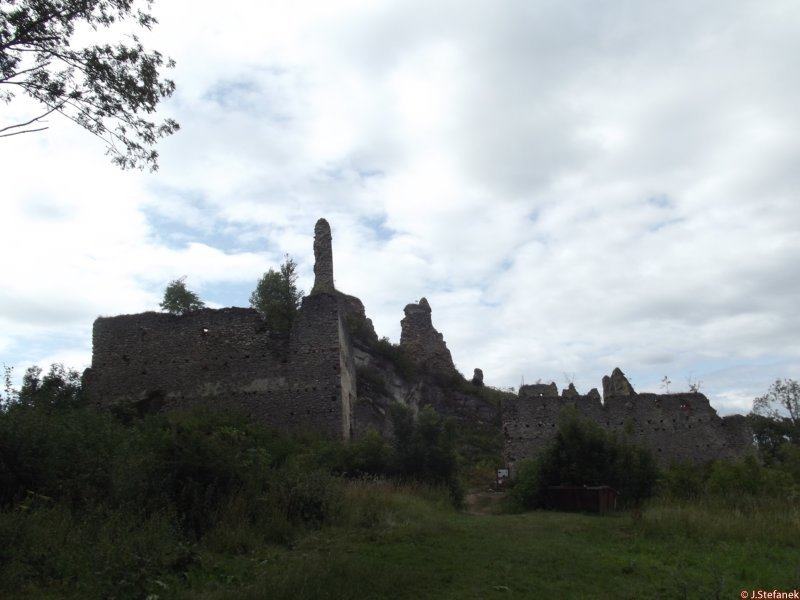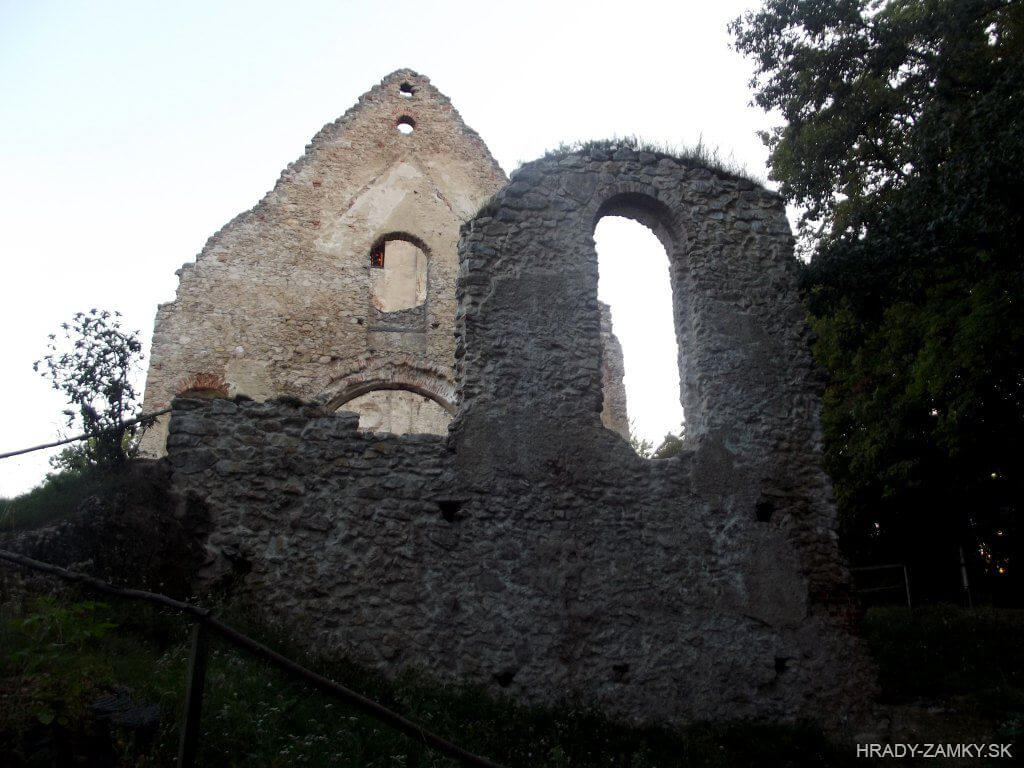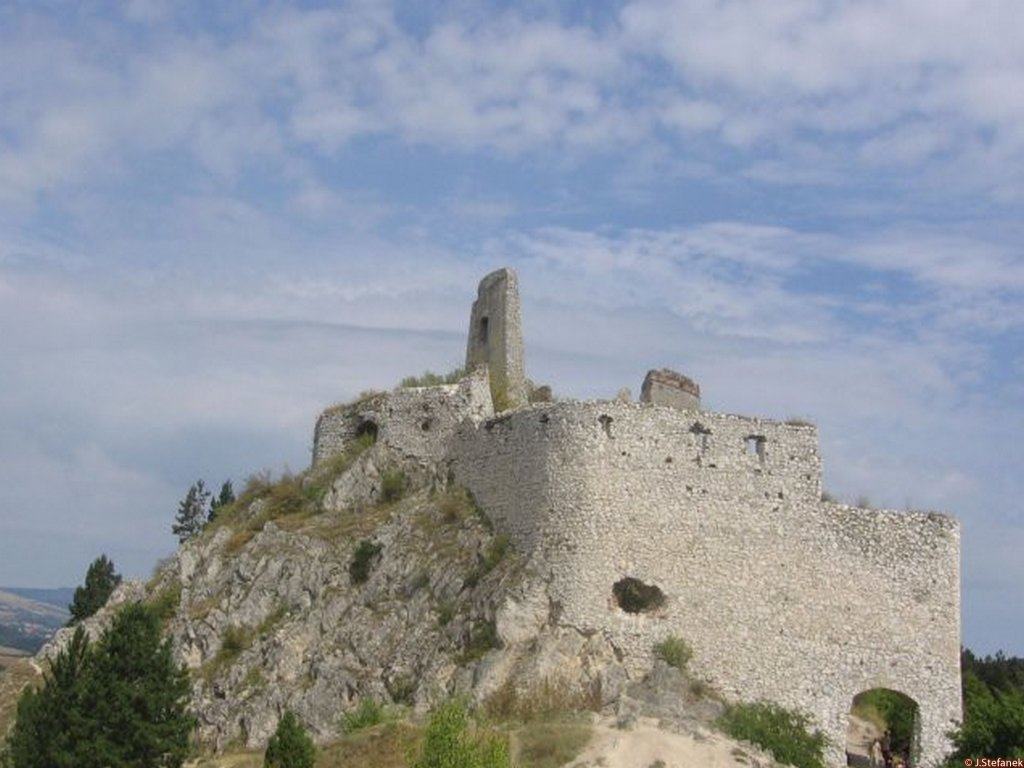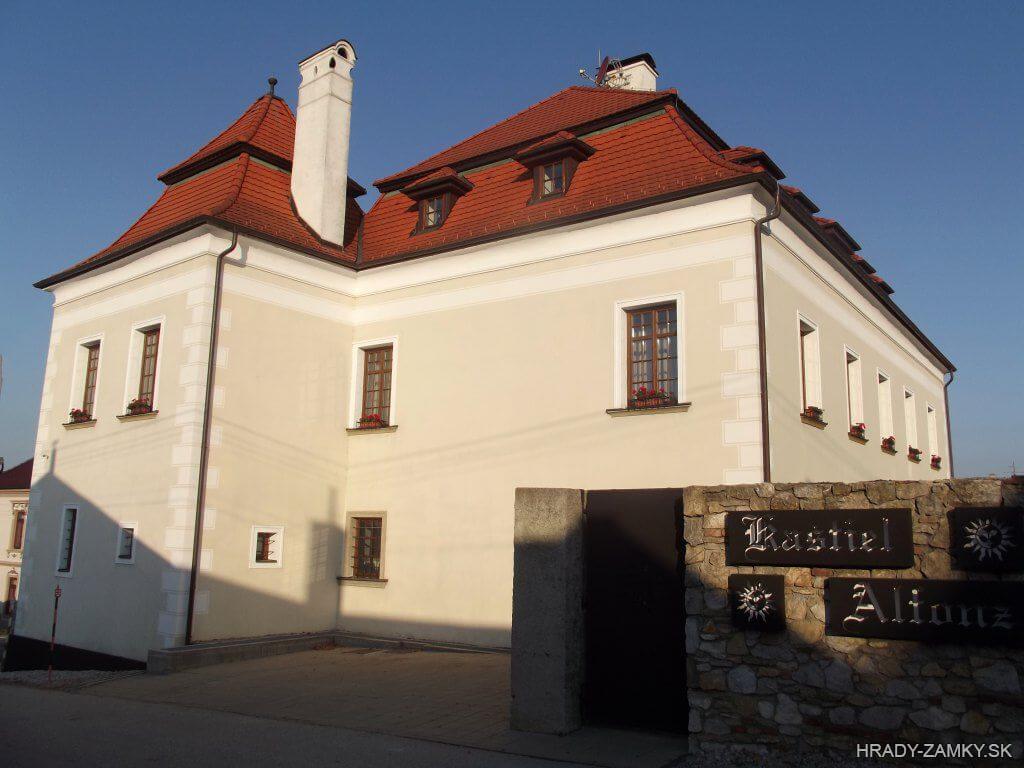Branč
Podbranč Trnava county Slovakia
castle ruin
Branč
Podbranč Trnavský kraj Slovakia
zrúcanina hradu
Partially, not very sensitively restored ruins of the castle on the parallel bars of Myjavská upland above the village Podbranč, local part Podzámok in the district Senica
Čiastočne, nie príliš citlivo pamiatkovo upravená zrúcanina hradu na bradle Myjavskej pahorkatiny nad obcou Podbranč, miestna časť Podzámok v okrese Senica.
Previous names
Berench, Berencz, Brancz, Berencs
Roads
Whether by car or on foot, from the village of Podbranč, specifically from its part of Podzámok, we can get on the asphalt road to the local cemetery, where there is a small parking lot next to the road reserved directly under the castle.We can park the car here - from this place it is only a short, taking only a few minutes, slightly rising asphalt road to the ruins of Branč castle. You can also shorten the path across the slope.
Či už autom alebo pešo, z obce Podbranč, konkrétne z jej časti Podzámok, sa dostaneme po asfaltovej ceste až k miestnemu cintorínu, kde je popri ceste vyhradené menšie parkovisko priamo pod hradom.Auto tu môžeme zaparkovať - odtiaľto je to len kratučký, pár minútový, mierne stúpajúci výstup po asfaltovej cestičke až k zrúcanine hradu Branč. Cestu si môžete aj skrátiť krížom po svahu.
Description
The oldest parts of the castle are part of a two-space palace block on the eastern side of the inner castle courtyard.The castle is divided into two main parts: lower castle and middle castle. The middle castle is separated from the lower castle by a significantly dry deep moat, which increased the natural height of the fortification of the middle castle. The entrance to the middle castle was originally in the corner (opposite the monument). Even where the ground is aligned (where there is no ditch - it was, but the ground was covered by the fall of the upper and middle castle), the attackers had to overcome the 80 m ditch under the direct fire of the castle defenders.The middle castle is functionally divided into 2 parts: the northern courtyard and the residential palace. From the courtyard, the staircase led to the atrium courtyard and the individual rooms. There were 40 rooms - 15 on the ground floor, 20 on the first floor and 5 on the second floor. There was a well in the western courtyard of the lower castle. The older well was also in the courtyard of the middle castle (near the only accessible room).The memorial on the western plateau was built in 1939 and reminds the suffering of imprisoned Protestant priests.
Najstaršie časti hradu sú súčasťou dvojpriestorového palácového bloku na východnej strane nádvoria vnútorného hradu.Hrad je rozdelený na dve hlavné časti: dolný hrad a stredný hrad. Stredný hrad je od dolného hradu oddelený výrazne suchou hlbokou priekopou, ktorá zvyšovala prirodzenú výšku opevnenia stredného hradu. Vchod do stredného hradu bol pôvodne v rohu (oproti pomníku). Aj tam, kde je zem zarovnaná (kde nie je priekopa - bola, ale sa zem zasypala spadnutím horného a stredného hradu), útočníci museli prekonať 80 m priekopu pod priamou paľbou obrancov hradu.Stredný hrad sa funkčne delí na 2 časti: severné nádvorie a obytnú palácovú časť. Z nádvoria sa po schodisku vystupovalo do átriového dvora a do jednotlivých miestností. Bolo tu 40 izieb - 15 v prízemí, 20 na prvom poschodí a 5 na druhom poschodí. Na západnom nádvorí dolného hradu bola hradná studňa. Staršia studňa bola i na nádvorí stredného hradu (blízko jedinej sprístupnenej miestnosti).Pomník na západnej plošine bol postavený v r.1939 a pripomína utrpenie väznených protestantských kňazov.
Plan
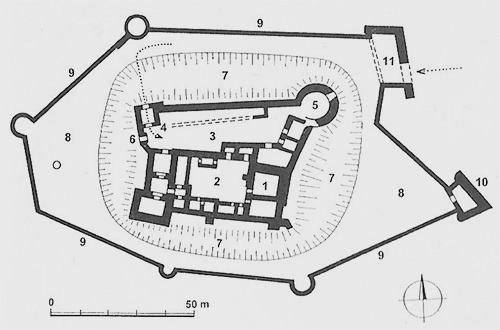
Legend to the ground plan
- 1 - residential tower of the Early Gothic fortress
- 2 - atrium courtyard
- 3 - northern courtyard
- 4 - entrance tower of the inner castle
- 5 - bastion
- 6 - entrance gate
- 7 - moat
- 8 - courtyard of the lower castle
- 9 - external fortification with bastions
- 10 - bastion
- 11 - entrance to the castle
Legenda k pôdorysu
- 1 - obytná veža včasnogotickej pevnosti
- 2 - átriový dvor
- 3 - severné nádvorie
- 4 - vstupná veža vnútorného hradu
- 5 - bašta
- 6 - výpadová bránka
- 7 - priekopa
- 8 - nádvorie dolného hradu
- 9 - vonkajšie opevnenie s baštami
- 10 - bastión
- 11 - vstup do hradu
History
Branč Castle is one of the oldest castles in Záhorie. According to the findings of coins from 1251 - 1261, probably during this period, the castle was built by Master Aba of Hlohovec. In 1297, the Abovci family exchanged the manor with the stone castle Branč for other property to the master Abraham Rúfus, and in 1309 Matúš Čák Trenčiansky forced him to leave the castle manor to him. After Matúš's death, the castle was owned for some time by his relative, Štefan of Šternberk. For a short time, the castle was also owned by King Karol Róbert, the Czech King Ján Luxemburg, and in 1394 by Sigismund of Luxembourg. Then Sigismund donated the castle to Stibor of Stiborice. After this year, the reconstruction of the middle castle dates back. The result was a typically Gothic rock castle with an attack tower, palace, chapel and in the southeast corner of the middle castle with a high wall perimeter wall.
Around 1453, the castle was seized by the famous thug and warrior Pongrácz from Sv. Mikuláš, who used the castle as his base for raidings on Moravia and Austria. At the beginning of the 16th century, Mr. Osvald, the owner of the nearby Korlátka castle, acquired a share in the manor, while the second part belonged to Euprosine Pongráczová, married to Bernard Nyári. After the battle of the Hungarian troops with the Ottomans near Mohács in 1526, František Nyári, the son of Eufrozína, moved to his mother's estate and by marrying Osvald's granddaughter Alžbeta, he also acquired part of his estate. In 1551, František Nyári died childless and bequeathed his property to relatives. The last members of the Nyári family also lived here with the whole family, who built a new manor house in Sobotišťe and gradually moved there.
The next Thököly uprising was a harbinger of the demise of the castle, which was fought for in 1683. Branč Castle was managed only by the castellan. The castle was a temporary prison for Protestant priests who were sentenced to galleys. They died in the so-called pits - prison around the perimeter of the wall. A memorial in the courtyard commemorates this event. At the beginning of the 18th century, the desolate buildings of the castle were intentionally damaged by the former owners and the defensive equipment also failed. The castle was no longer inhabited and was abandoned.
In 1968, a monumental restoration of the castle was carried out, but it was not completed. Archaeological research has been carried out on the castle since 1978.
Hrad Branč patrí k najstarším hradom na Záhorí. Podľa nálezov mincí z r.1251 - 1261, pravdepodobne v tomto období nechal postaviť hrad magister Aba z Hlohovca. V r.1297 Abovci zamenili panstvo s kamenným hradom Branč za iné majetky magistrovi Abrahámovi Rúfusovi a toho v r.1309 Matúš Čák Trenčiansky donútil, aby mu hradné panstvo prenechal. Po Matúšovej smrti istý čas vlastnil hrad jeho príbuzný magister Štefan zo Šternberka. Krátku dobu hrad vlastnil i kráľ Karol Róbert, český kráľ Ján Luxemburský, a v roku 1394 Žigmund Luxemburský. Potom Žigmund daroval hrad Stiborovi zo Stiboríc. Po tomto roku sa datuje prestavba v rozsahu stredného hradu. Výsledkom bol typicky gotický skalný hrad s útočnou vežou, palácom, kaplnkou a v juhovýchodnom rohu stredného hradu s vysokým hradbovým obvodovým múrom.
Okolo r.1453 sa hradu zmocnil známy násilník a bojovník Pongrácz zo Sv. Mikuláša, ktorý hrad využíval ako svoju základňu pre lúpežné vpády na Moravu i do Rakúska. Na začiatku 16.storočia nadobudol podiel na panstve pán Osvald, majiteľ neďalekého hradu Korlátka, zatiaľ čo druhá časť patrila Eufrozíne Pongráczovej, vydatej za Bernarda Nyáriho. Po bitke uhorských vojsk s Osmanmi pri Moháči v r.1526 sa František Nyári, syn Eufrozíny, presťahoval na brančský majetok svojej matky a sobášom s Osvaldovou vnučkou Alžbetou získal aj jeho časť panstva. V r.1551 František Nyári zomrel ako bezdetný a svoje majetky odkázal príbuzným. S celou rodinou tu žili i poslední príslušníci rodu Nyári, ktorí si postavili nový kaštieľ v Sobotišti a postupne sa tam presťahovali.
Nasledujúce Thökölyho povstanie bolo už predzvesťou zániku hradu, o ktorý sa bojovalo ešte v r.1683. Hrad Branč spravoval už len kastelán. Hrad bol prechodnou väznicou protestantských kňazov, ktorí boli odsúdení na galeje. Zomreli v tzv. jamách - väznica po obvode múru. Túto udalosť pripomína pamätník na nádvorí. Pustnúce objekty hradu na začiatku 18.storočia úmyselne poškodili bývalí majitelia a znefunkčnili i obranné zariadenia. Hrad už potom vôbec nebol obývaný a pustol.
V r.1968 bola prevedená pamiatková obnova hradu, ktorá ale nebola dokončená. Od r.1978 na hrade prebiehal archeologický výskum.
Myths and legends
The rumor says
When Branč was ruled by Mr. Pongrácz, he beat him forever on the neighboring estates. What he stole, he sold in a meadow under the castle as a fair.
Death of a robber knight
The robber knight Pongrácz seized the castle by force and had the former owners murdered. One evening, he let his guard go to the surrounding villages for fun, and he himself proudly walked around the quiet castle. Here he saw a deflected door to the basement. He came in and started down the hall, which seemed to have no end. Suddenly there was a piercing whistle in front of him and something black flew straight into his face. He felt a shock, a burning pain, and darkness in his eyes. He blindly waved his dagger in a convulsion, and the next day he was found stuck on his face and with a dagger deep in his chest. God's justice has found him. The robber knight may have killed himself, with only the soulless body of a large bat.
Black lady
Once upon a time, the castle lord lived here with a beautiful but very picky daughter. She found a mistake on each questioner. The father was patient and cursed the daughter. Since then, she has wandered around the castle at night like a black lady looking for someone to knock her out. The condition is that the person concerned must not be frightened. For example, she once snatched a shepherd and after three nights appeared to him in various forms. The first night the shepherd of the giant toad was not frightened, but the second night he escaped from the monster snake. On the third night, the girl told him that he was not a hero who deserved the castle's treasures. The black lady is still looking for a daredevil who would not take his legs on his shoulders for fear of her transformation.
Povráva sa
Keď Branču vladáril pán Pongrácz, večne zbíjal na susedných panstvách. Čo nakradol, predával na lúke pod hradom ako na jarmoku.
Smrť lúpežného rytiera
Lúpežný rytier Pongrácz sa hradu zmocnil násilím a bývalých majiteľov dal zavraždiť. Raz večer pustil svoju stráž za zábavou do okolitých dedín a on sám sa hrdo prechádzal po tichom hrade. Tu zazrel odchýlené dvere do podzemných priestorov. Vošiel sem a pustil sa chodbou, ktorá akoby nemala konca. Zrazu sa pred ním ozval prenikavý piskot a čosi čierne mu vletelo rovno do tváre. Pocítil náraz, pálčivú bolesť a v očiach tmu. Poslepiačky sa v kŕči oháňal dýkou a na druhý deň ho našli dodriapaného na tvári a s dýkou hlboko v hrudi. Božia spravodlivosť si ho našla. Lúpežný rytier sa možno zabil sám a pri ňom ležalo iba bezduché telo veľkého netopiera.
Čierna pani
Kedysi dávno tu totiž žil hradný pán s krásnou, ale veľmi prieberčivou dcérou. Na každom pytačovi našla chybu. Otca prešla trpezlivosť a dcéru preklial. Odvtedy blúdi nocou po hrade ako čierna pani a hľadá niekoho, kto by ju odklial. Podmienkou je, že sa jej dotyčný nesmie zľaknúť. Raz napríklad naďabila na pastiera a po tri noci sa mu zjavovala v rôznych podobách. Prvú noc sa pastier obrovskej ropuchy nezľakol, ale druhú noc pred ozrutným hadom ušiel. Tretiu noc mu dievka oznámila, že nie je hrdina, čo by si zaslúžil hradné poklady. Čierna pani tak dodnes hľadá odvážlivca, ktorý by zo strachu pred jej premenou nezobral nohy na plecia.
Useful information
Opening hours and admission
Otváracia doba a vstupné
External links
Nearby castles
